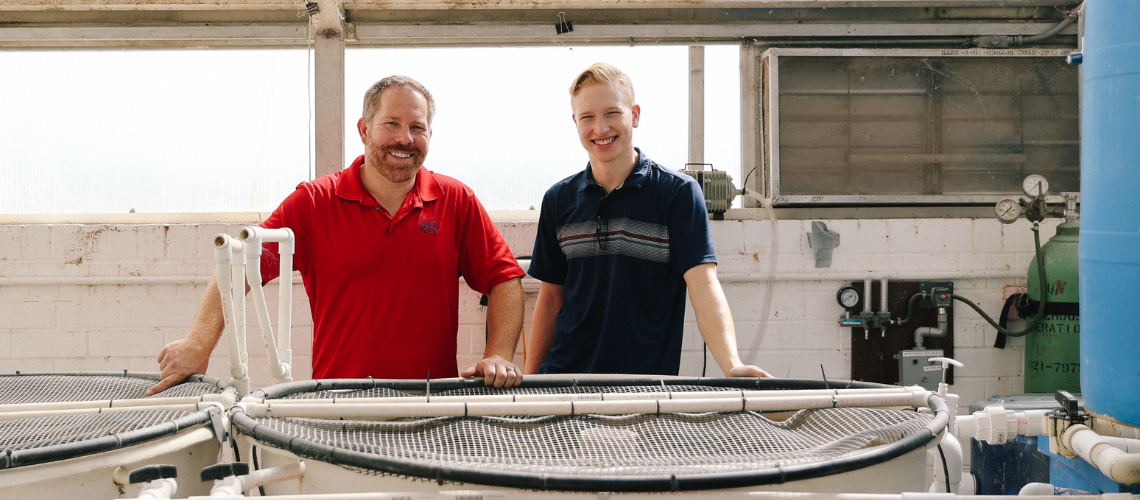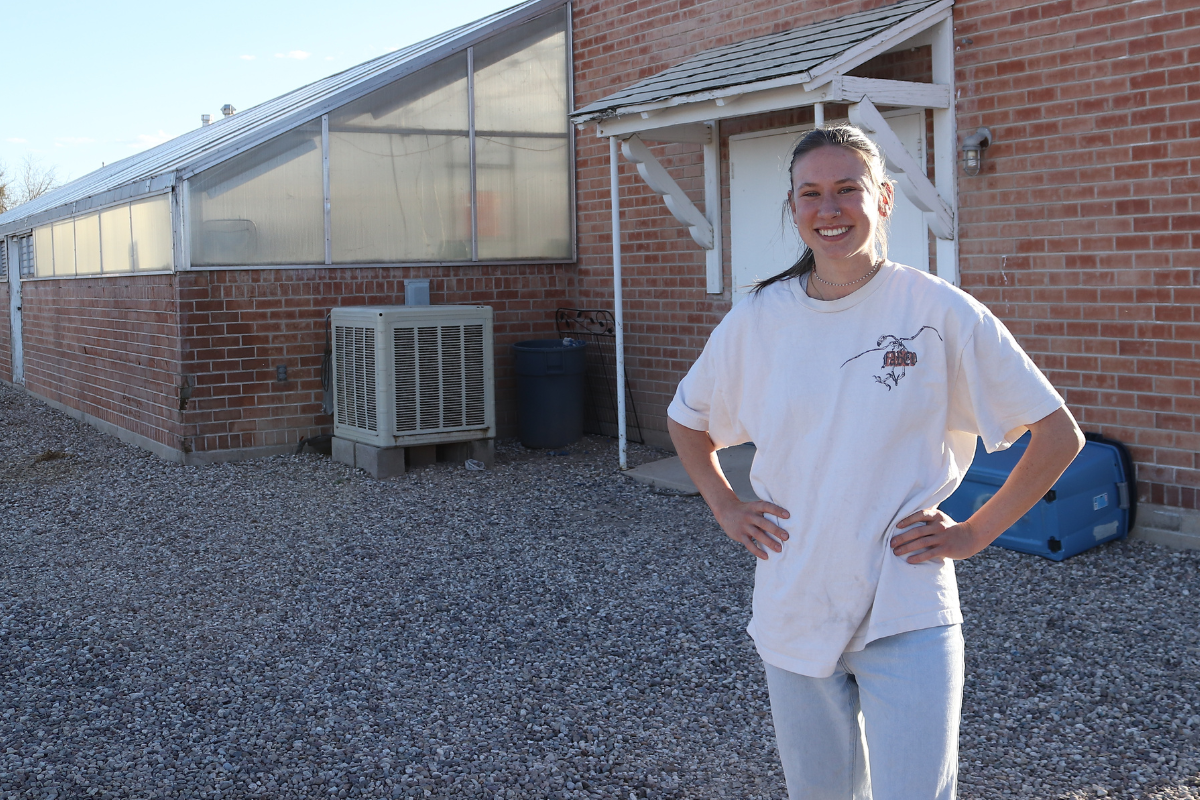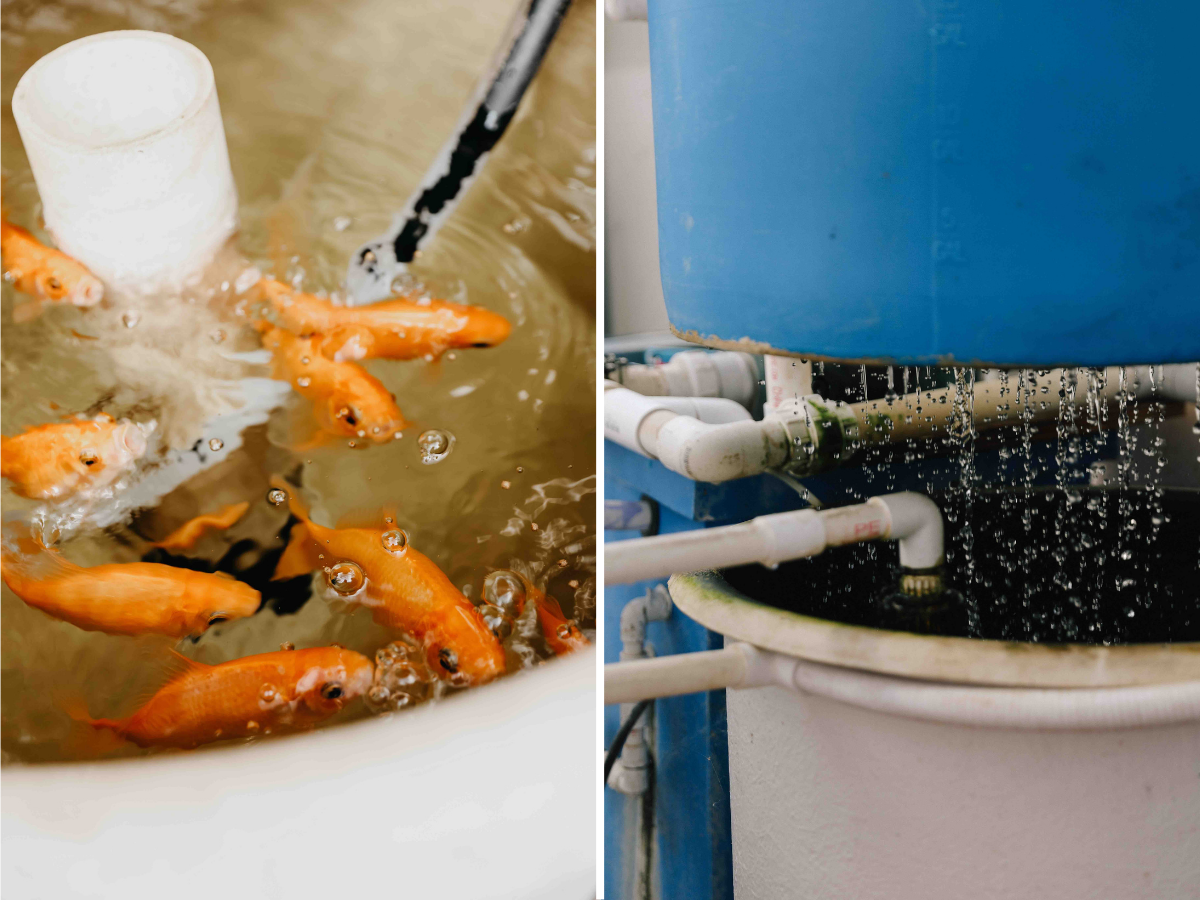
By Madison Gerdes, Campus Sustainability Fund
Tucked away at the Controlled Environment and Agriculture Center (CEAC) at Campbell Ave and Allen Road is an aquaponics greenhouse where UArizona’s Dr. Matthew “Rex” Recsetar and Biosystems Engineering seniors Benjamin Hunt and Gracie Reinholz are paving the way in sustainable agriculture practices. Aquaponics is a water-based agriculture technique that mimics a natural ecosystem and uses fish waste as food for bacteria, which in turn converts into a fertilizer for plants. Supported by a $5,000 Mini Grant from the Campus Sustainability Fund, Ben and Gracie’s “Sustainable Citrus Plus” project takes aquaponics to the next level, using biosolids from the tilapia and goldfish kept in the greenhouse to fertilize and grow citrus and stone-fruit trees outside of the greenhouse. The system they set up includes a rainwater collection system paired with a sump tank and drip irrigation. This design dilutes nutrients to the necessary level for tree irrigation without depleting the nutrients in the aquaponics system. Once they mature, the trees will have the added benefit of cooling the greenhouse to minimize the cost of air conditioning in warmer parts of the year.

The fruit itself will be donated to Campus Pantry, allowing this project to reach students on campus, despite its distance and the fact that many students have never heard of the CEAC. To help spread the word, Hunt and Reinholz are offering tours of their facility and project. Through these tours, they hope to inform the public about CEAC, teach students and the local Tucson community about the environmental benefits of an aquaponics system, and show how the Sustainable Citrus Plus project can provide innovative solutions to the challenge of feeding growing populations while agricultural land is decreasing worldwide.
 Another benefit, says Hunt, is the "more natural ways aquaponics offers to irrigate your plants and provide nutrients,” while relying "less on salts and solutions as hydroponic systems do.” Hydroponics, another water-based agricultural practice, is similar to aquaponics but does not include fish in the system. Hunt elaborates that “the water is always recirculated in aquaponics” and the specifics of the water and fish working together in a closed system means that aquaponic systems could be “extremely beneficial for the fishery industry to start growing plants to serve as a sort of filter on their raceways,” which is a water channel used for high volume fish production.
Another benefit, says Hunt, is the "more natural ways aquaponics offers to irrigate your plants and provide nutrients,” while relying "less on salts and solutions as hydroponic systems do.” Hydroponics, another water-based agricultural practice, is similar to aquaponics but does not include fish in the system. Hunt elaborates that “the water is always recirculated in aquaponics” and the specifics of the water and fish working together in a closed system means that aquaponic systems could be “extremely beneficial for the fishery industry to start growing plants to serve as a sort of filter on their raceways,” which is a water channel used for high volume fish production.
For the Sustainable Citrus Plus project, the use of aquaponic byproducts for “woody outdoor plants” rather than the normal leafy and herbaceous ones found in most controlled environment systems is another way this project is pushing the limits of traditional aquaponics systems. This rendition experiments with larger-scale food production and non-traditional food types. Additionally, by installing their own rainwater harvesting system and sump pump to control the amount of fertilizer added to the trees, the team is able to minimize the amount of city water needed and forgo store-bought soil amendments entirely.

Right: Water percolates through the filtration system.
The closed loop system Hunt and Reinholz have created has a multitude of benefits. In addition to the water and energy savings, and sustainable agriculture practices, they also don’t have to worry about waste outputs. Hunt shares, “this is helpful for the environment and usually in terms of agriculture, provides organic or healthier ways to support plant growth.”
The process has not been without its struggles, however. “The most difficult part is simply unforeseen hiccups,” says Hunt. “We had some difficulty with getting our rainwater cistern ordered, finding the sewage line running from the greenhouse, and the pressure in the irrigation system. We are still working on the irrigation system pressure problem and have some things to try to equalize the pressure.” But for Gracie and Ben, the struggles have been worth it. And while he may never “get to taste the fruit of his labor (literally),” getting to “start something that students can enjoy for years” and knowing that “these trees are only going to get bigger, that they are being grown sustainably, and that even in the desert we can find solutions to problems like water and fertilizer shortages, is pretty awesome.”
Want to get involved with the Sustainable Citrus Plus Project, tour the facility, or simply learn more? Contact the project managers at huntbenjamin02@arizona.edu and reinholz1@arizona.edu or Dr. Recsetar at msrecs@arizona.edu.
Interested in learning more about funding for grants like this? Check out the Campus Sustainability Fund website at https://sustainability.arizona.edu/csf or contact the Fund Coordinator, Emily Haworth, at emilyhaworth@arizona.edu.
